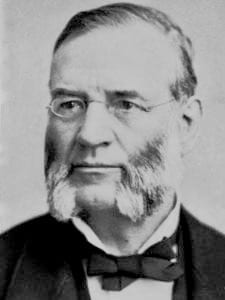Austin Flint
Austin Flint (1812-1886) was an American Physician.
Flint had a specialist interest in diseases of the heart and lungs and was a firm believer in the importance of clinical examination. Flint was a gifted teacher, founder of two medical schools and professor in six medical schools. Flint co-founded the medical schools of Buffalo Medical College (now the State University of New York at Buffalo) and Bellevue Medical College (later amalgamated with the New York University College of Medicine)
In 1859 he wrote the first American textbook on heart disease, placing great detail on auscultation and description of murmurs. Among the first to recognise the importance of normal cardiac and respiratory sounds and encouraged routine auscultation on all patients.
Flint coined the term ‘broncho-vesicular breathing‘ and the importance of the pitch of percussion notes in clinical diagnosis, providing great detail in his ‘Manual of Percussion and Auscultation‘ (1876). Perhaps most notably, his name is attributed to the mid-diastolic aortic regurgitant murmur heard at the apex – the Austin Flint Murmur (1862)
Biography
- Born on October 20, 1812, Petersham, Massachusetts. His father, grandfather and great-grandfather were also physicians.
- 1833 – Graduated from Harvard Medical School.
- 1835– Married Anne Skillings; their son, Austin Flint, Jr., who became a prominent physiologist, was born in 1836.
- 1844 – Professor of Medical Theory and Practice at Rush Medical School, Chicago.
- 1845 – Founded and edited the Buffalo Medical and Surgical Journal.
- 1847 – Founded the Buffalo Medical School.
- 1852 – Became Professor of the Theory and Practice of Medicine, University of Louisville.
- 1860 – Professor of Pathology and Practice Medicine at Long Island College Hospital in Brooklyn.
- 1861 – Helped found Bellevue Hospital and Medical School and became Professor of theoretical and practical medicine.
- 1883 – President of the American Medical Association.
- 1868 – Retired, but continued to teach until he died suddenly in March 1886 of a cerebral haemorrhage after attending a meeting of the faculty of the Bellevue Medical College the evening before.
- Died on March 13, 1886
Medical Eponyms
Austin Flint Murmur (1862)
A mid-diastolic to late diastolic or presystolic mitral murmur best heard at the apex that is low-pitched and rumbling in the presence of aortic regurgitation with no underlying mitral pathology
The murmur is oftener rough than soft. The roughness is often peculiar. It is a blubbering sound, resembling that produced by throwing the lips or the tongue into vibration with the breath of respiration
Flint A. 1862: 50
Flint’s Law (1852)
The relationship of elevated audible pitch and diminished percussion resonance in pulmonary consolidation.
An elevation of pitch always accompanies diminution of resonance in consequence of pulmonary consolidation. In other words, dullness of resonance is never present without the pitch being raised.
Austin Flint 1852: 5
Controversies
Flint was a harsh critic of eponymous names…
So long as signs are determined from fancied analogies and named from those or after the person who describes them, there cannot but be obscurity and confusion.
Bull Johns Hopkins Hosp 1912; 23: 184
Major Publications
- Flint A. On variations of pitch in percussion and respiratory sounds, and their application to physical diagnosis: prize essay, 1852.
- Flint A. A Practical Treatise on the Diagnosis, Pathology and Treatment of Diseases of the Heart. Blanchard and Lea, 1859.
- Flint A. On Cardiac Murmurs. American Journal of the Medical Sciences. 1862;44:29-54. [Austin Flint murmur]
- Flint A. A treatise on the principles and practice of medicine: designed for the use of practitioners and students of medicine. 1868
- Flint A. A text-book of human physiology. 1875
- Flint A. A manual of percussion and auscultation: of the physical diagnosis of diseases of the lungs and heart, and of thoracic aneurism. 1876
- Flint A. Clinical medicine: a systematic treatise on the diagnosis and treatment of diseases: designed for the use of students and practitioners of medicine 1879.
- Flint A. Medical ethics and etiquette: the code of ethics adopted by the American Medical Association. 1883.
- Flint A. Medicine of the future; an address prepared for the annual meeting of the British medical association in 1886.
References
Biography
- Landis HRM. Austin Flint: his contributions to the art of physical diagnosis and the study of tuberculosis. Bull Johns Hopkins Hosp 1912;23:182–186
- Obituary: Dr. Austin Flint, Physiologist, Dies. New York Times Archives. September 23, 1915.
- Mehta NJ, Mehta RN, Khan IA. Austin Flint: Clinician, Teacher, and Visionary. Tex Heart Inst J. 2000; 27(4): 386–389.
- Editorial: Austin Flint (1812-1886). Heart Views. 2011; 12(4): 183–184.
- Bibliography. Flint, Austin. WorldCat Identities
Eponymous terms
- Evans AS. Austin Flint and his contributions to medicine. Bull Hist Med 1958;32:224–41.
- Sternbach G, Varon J. Austin Flint: on cardiac murmurs. J Emerg Med. 1993; 11(3): 313-5.
- Mehta NJ, Khan IA. Original descriptions of the classic signs of aortic valve insufficiency. J Emerg Med. 2003 Jan;24(1):69-72.
- Zhang G. Eponyms in Aortic Regurgitation. LITFL 2019
- Robbins A, Zhang G, Cadogan M. Name that murmur. LITFL 2022
- Cadogan M. Austin Flint murmur. Eponym A Day. Instagram
[cite]

